The United States National Park Service has recorded 423 national park sites in their system since it was founded in 1961. Out of these parks, only 63 are recognized and established as prominent ‘national parks’.
In 1872, President Ulysses S. Grant granted and recognized the Yellowstone National Park as the first protected land. Today, more lands and regions are being set apart and preserved as national gems.
Ranging from diverse redwoods forests to beautiful epic canyons, every national park carries its own uniqueness that attracts more visitors year after year.
With that said, these are all national parks in the United States, categorized by state:
Table of Contents
Alaska
1. Lake Clark National Park

This amazingly preserved land offers tons of exciting activities to visitors who love an off-grid experience. Through the Alaska National Interest Lands Conservation Act, this land was established and preserved as a national park in 1980.
Apart from the pleasing view of the turquoise-colored lake, visitors can enjoy watching wild salmons swimming freely in the Kijik River and Silver Salmon Creek, volcanoes steam, and more importantly, the possibility to witness wild brown bears forage in the wilderness.
- Best time to visit: Open during summer. Bear watching can be done in June while fishing is best in July and August.
- Admission fee: None
- More information can be found on this website: https://www.nps.gov/lacl/index.htm
2. Gates of the Arctic National Park
Nominated as the 2nd biggest national park in the United States, this place is located completed above the Arctic Circle and can only be reached by boats, planes, or on foot. To reach this place, you have to fly out of Fairbanks to a remote town on the edge of the Arctic Circle.
Established and preserved as a national park in 1980, this land is rich in natural beauty like glacier-carved valleys, wild caribou wandering along the trails, 24 hours of sunlight during summer, and Aurora-Borealis night sky in the winter.
- Best time to visit: Summer, for clear and better weather.
- Admission fee: None
- More information can be found on this website: https://www.nps.gov/gaar/index.htm
3. Kobuk Valley National Park
Kobuk Valley was established as a national park in 1980 through the Alaska National Interest Lands Conservation Act. This land doesn’t have any designated trails. Visitors are free to roam this park and venture into the wilderness.
Some of the attractions of this land are the Great Kobuk Sand Dunes and diverse wetlands that are inhabited by different wildlife like beavers, black bears, salmon, and Alaskan moose.
- Best time to visit: Summer. Caribou viewing is best during spring and fall.
- Admission fee: None
- More information can be found on this website: https://www.nationalparks.org/connect/explore-parks/kobuk-valley-national-park
4. Glacier Bay National Park
Located in southeast Alaska west of Juneau, these 3.3 million acres of preserve land were established as a national park on December 2, 1980.
Glacier Bay National Park is in different variety of natural attractions such as mountainous glaciers, deep sheltered fjords, shimmering coastlines, and home to many wildlife, fish, and plants. F
or anyone who is looking for a quick escape from busy cities, this land will offer solitude and a remote experience in the wilderness.
- Best time to visit: Late spring when fewer people are visiting.
- Admission fee: $20 per individual, $35 per vehicle, valid for 7 days.
- More information can be found on this website: https://www.nationalparks.org/connect/share-your-park/glacier-bay-national-park
5. Wrangell-St. Elias National Park
This 13.1 million acres of land is the largest national park in the United States. Wrangell-St. Elias National Park encompasses the Saint Mountain range and few other mountains with dozens of icefields and glaciers.
Established as a national park on December 2, 1980, this land is well-known for its beauty including the old mining town of Kennecott, the Skookum volcano, the Liberty Falls, and the Root Glacier.
Visitors are welcome to experience an adventure in the wilderness that is rich in unique flora like black spruces, Labrador tea, and large wild grizzly bears, timber wolves, caribou, and black bears.
- Best time to visit: During summer when the park’s main roads are frequently maintained.
- Admission fee: None
- More information can be found on this website: https://www.travelalaska.com/Destinations/Parks-and-Public-Lands/Wrangell-St-Elias-National-Park.aspx
6. Kenai Fjords National Park

Established in 1980, this park holds one of the largest ice fields in the United States, the Harding Icefield. Located close to the town of Swears, Kenai is well-known for its popular cruise ship and boat tours for glacier-viewing activities.
Wildlife sighting is also one of the attractions. Sea otters, dolphins, wild orcas, and humpback whales are some of the animals that would frequently inhabit this park.
Not to mention, avid campers and hikers are provided with several campgrounds and hiking trails to get the best experience out of this place.
- Best time to visit: During summer to get the most out of the boat trips.
- Admission fee: None, except for the boat trips.
- More information can be found on this website: https://www.alaskacollection.com/day-tours/kenai-fjords-tours/kenai-fjords-national-park-tour/
7. Denali National Park
Denali National Park was established as a national park on December 2, 1980. Being the largest national park in this country with the highest mountain, Denali offers many amazing natural attractions like the Kahiltna glacier, taiga forest, tundra, and mountainous land.
Other activities that can be done in this place include hiking, dog-sledding, climbing, snowboarding, and cross-country skiing. This place is also a home for animals like the Alaskan moose, caribou, grizzly and black bears.
- Best time to visit: During summer when the road is accessible by vehicle or tour buses.
- Admission fee: $15 per individual, valid for 7 days.
- More information can be found on this website: https://www.reservedenali.com/
8. Katmai National Park
Established in 1980 as a national park, Katmai preserve is located on the coast of Southern Alaska with several large bodies of water and lakes like Nanek river, Kukaklek river, and Alagnak river.
This place is also famous for its Alaskan brown bears and mountainous landscapes like Mount Mageik and Mount Katmai. Apart from bear-watching, visitors can also participate in other activities such as camping, kayaking, fishing, and hiking.
- Best time to visit: July to September, when the services are open. This period also is the best time for bear-watching.
- Admission fee: None
- More information can be found on this website: https://www.nps.gov/katm/index.htm
Arizona
9. Grand Canyon National Park

Located in northwestern Arizona, this land was established as a national park on February 26, 1919. Grand Canyon is the largest canyon measuring around 1.2 million acres with the Colorado river on the edge of it.
For avid canyoneers or explorers, some of the activities that shouldn’t be missed are canoeing along the 277-mile long Colorado river and a hike up the Bright Angel Trail.
- Best time to visit: During cool weather in winter.
- Admission fee: $20 per individual, $35 per vehicle, valid for 7 days.
- More information can be found on this website: https://grandcanyon.com/
10. Saguaro National Park
Saguaro National Park received its name from the abundance of large ‘saguaro’ cacti that can be found there.
Located in Pima County, southeastern Arizona, this park is split into two districts; the Tucson Mountain District and the Rincon Mountain District. It was established as a national park on October 14, 1994.
Apart from different cactus species, there are numerous activities that can be done in this park such as cycling, horse riding, camping, and hiking. Visitors can drive many scenic routes such as the Bajada Loop Drive, the Desert Discovery Natural Trail, and the Cactus Garden Trail.
- Best time to visit: In the spring for blooming cacti.
- Admission fee: $10 per individual, $20 per vehicle, valid for 7 days.
- More information can be found on this website: http://www.saguaronationalpark.com/
11. Petrified Forest National Park
The Petrified Forest National Park is located in Najavo and Apache counties in northeastern Arizona. This land was established as a park on December 9, 1962, and is named after the huge amount of petrified wood that can be found there.
Several landmarks to capture visitors’ attention are the Painted Desert Rim, the Crystal Forest, the Blue Mesa, and the Agate House.
Wildlife like plateau striped whiptails, collared lizards, black-tailed jackrabbits, pronghorns, foxes, coyotes, and bobcats can be found on this land.
- Best time to visit: In the spring for blooming wildflowers and the fall for the best weather.
- Admission fee: $15 per individual, $25 per vehicle, valid for 7 days.
- More information can be found on this website: https://www.nps.gov/pefo/index.htm
Arkansas
12. Hot Springs National Park
Considered the smallest of the 63 national parks, Hot Springs is located in central Garland Country, Arkansas. This urban, town-like park was established and designated as a national park on March 4, 1921.
Some of the famous bathhouses that are open to visitors are Ozark bathhouse, Lamar bathhouse, Quapaw bathhouse, and Buckstaff house.
The main attraction is the Bathhouse Row where people who bathe in this spot are said to experience healing water that can treat illnesses like arthritis and skin diseases.
On the outskirts of the town, there are few trails for people to hike and enjoy nature.
- Best time to visit: Any month except July to avoid the crowd.
- Admission fee: No entrance fee except for bathrooms.
- More information can be found on this website: https://www.hotsprings.org/
American Samoa
13. National Park of American Samoa
This unique national park is located in the Southern Hemisphere and encompasses three islands; Ofu, Tutuila, and Ta’u. National Park of American Samoa was established as national park on October 31, 1988.
In this park, visitors can explore the undisturbed ecosystem of each island, the diversity of sea life like coral reefs, and most importantly, the picturesque view of the beach on Ofu Island.
- Best time to visit: During the dry season from June to September.
- Admission fee: None
- More information can be found on this website: https://www.nps.gov/npsa/index.htm
California
14. Yosemite National Park

As one of the most popular national parks in the United States, Yosemite was established as a national park on October 1, 1890, before being designated as the World Heritage Site in 1984.
Located in northern California, this park is surrounded by Sierra National Forest on the southeast and Stanislaus National Forest on the northwest side.
Yosemite’s main attractions are its magnificent granite cliffs, amazing waterfalls, giant sequoia groves, and the abundance of flora and fauna in its wilderness. Numerous activities are allowed in this park including cycling, hiking, rock climbing, and scenic drives.
- Best time to visit: Late spring when there is less crowd and the roads are accessible.
- Admission fee: $20 per individual, $35 per vehicle, valid for 7 days.
- More information can be found on this website: https://www.yosemite.com/
15. Channel Islands National Park
The Channel Islands is a chain of eight islands located off the Pacific coast of California. Out of these eight islands, Santa Cruz is the largest one, owned by the Nature Conservancy. This place was established as a national park on March 5, 1980, and consists of five main islands: San Miguel, Santa Rosa, Santa Cruz, Anacapa, and Santa Barbara.
Some of the permitted activities that can be done here including kayaking, canoeing, hiking, scuba diving, and spearfishing.
- Best time to visit: In the spring for blooming wildflowers and winter for wildlife-watching.
- Admission fee: No entrance fee except for camping and tours fees.
- More information can be found on this website: https://www.nps.gov/chis/index.htm
16. Sequoia National Park
One of the landmarks of this beautiful park is the Giant Sequoia tree, which is among the largest and the tallest sequoia trees in the world. Located in the southern Sierra Nevada east of Visalia, California, this place was established as a national park on September 25, 1890.
Around 404,000 acres of this land is covered in Sequoia groves and the largest living tree on earth named General Sherman. Other beautiful landscapes that can be found are the Crescent Meadow, the High Sierra Trail, and the Moro Rock.
- Best time to visit: In the fall when fewer people are visiting.
- Admission fee: $20 per individual, $35 per vehicle, valid for 7 days.
- More information can be found on this website: https://www.nps.gov/seki/index.htm
17. Lassen Volcanic National Park
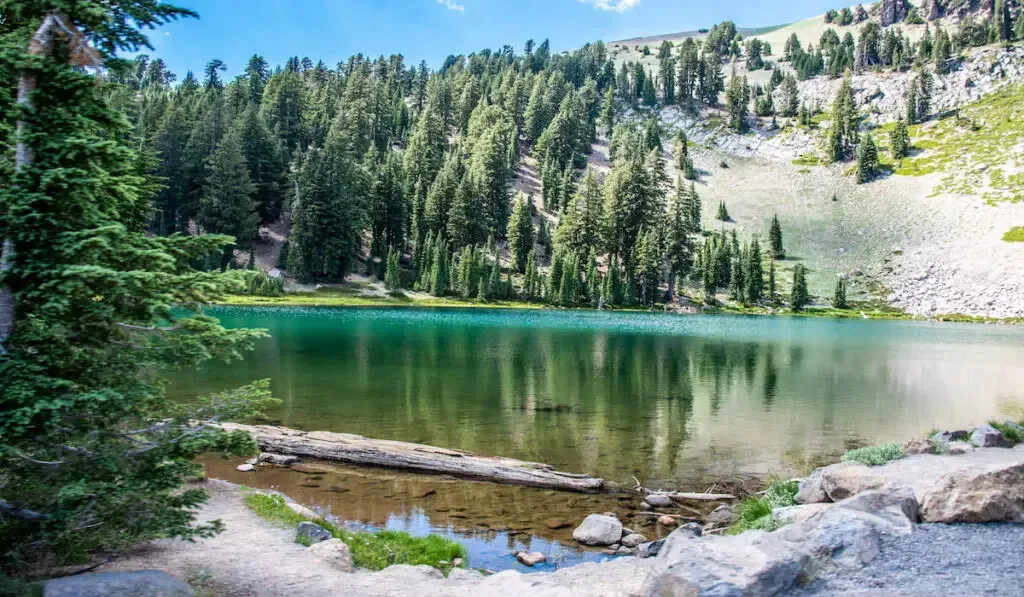
Lassen Volcanic National Park is located in northeastern California. This land was established as a national park on August 9, 1916. The prominent feature of this park is Lassen Peak, the largest plug dome volcano in the world.
Other beautiful landscapes that can be found here are craters, mountains, lava pinnacles, canyons, lakes, rivers, and sulfur vents. This volcanic park is also home to a variety of wildlife including red fox, coyotes, black bears, deers, mules, and cougars.
Hiking activities can be done on a designated trail called the Pacific Crest Trail.
- Best time to visit: During summer to avoid closed roads.
- Admission fee: $15 per individual, $30 per vehicle, valid for 7 days.
- More information can be found on this website: https://www.nps.gov/lavo/index.htm
18. Joshua Tree National Park
Established and designated as a national park on December 31, 1994, this land is well-known for its Joshua trees and its beautiful landscapes like the Colorado and Mojave deserts.
Although Joshua trees predominantly occupy most spaces of this park, there are other plant species that can be found here including California juniper, pinon pine, Tucker’s oak, and desert scrub oak.
A few hiking trails and camping parks have been made for visitors to experience the beauty of this park.
- Best time to visit: In the spring to watch blooming wildflowers.
- Admission fee: $15 per individual, $30 per vehicle, valid for 7 days.
- More information can be found on this website: https://www.joshuatree.org/
19. Redwood National Park
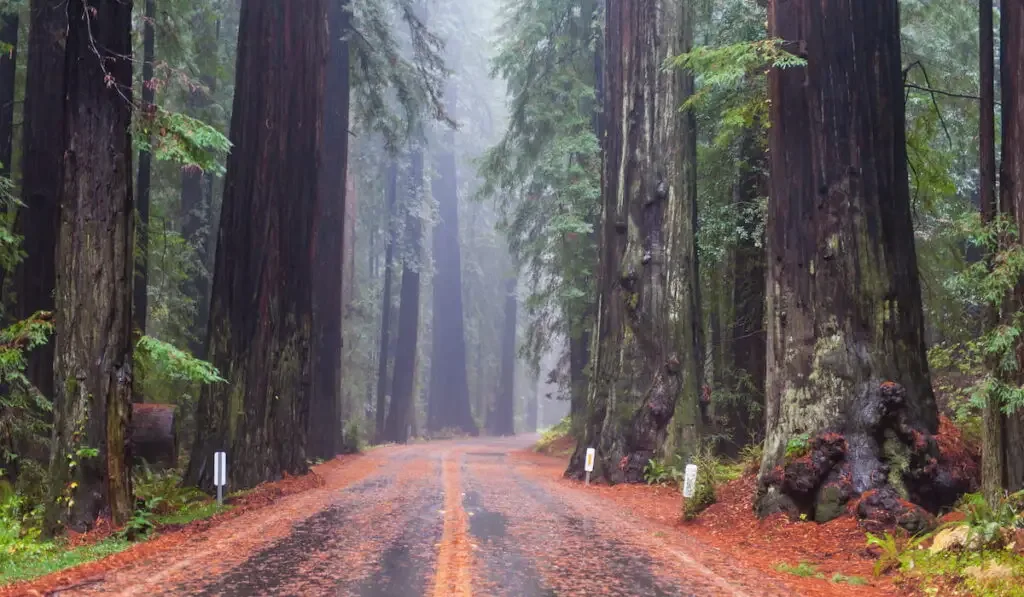
As one of the oldest temperate rainforests in the world, Redwood National Park is located along the coast of northern California.
Established as a national park on October 2, 1968, this park system has split the land into four separate regions: the Redwood Park, California’s Del Norte Coast, the Jedediah Smith, and the Prairie Creek Redwoods State Parks.
Some of the famous scenic landscapes that attract the most visitors are the Tall Tree Grove, the Lady Bird Johnson Grove, the Big Tree Wayside, and the Stout Memorial Grove.
- Best time to visit: From May to October for sunnier and clearer days.
- Admission fee: None
- More information can be found on this website: https://www.nps.gov/redw/index.htm
20. Kings Canyon National Park
Kings Canyon National Park is located in the southern Sierra Nevada in California. Established as a national park in 1890 but redesignated on March 4, 1940, this park can be divided into two separate regions; the Redwood Mountain Grove and the General Grant Grove.
The main attraction of this park is the General Grant Tree, which is the second-largest tree in the world. Aside from its fauna, Kings Canyon offers a lot of other interesting activities like camping, hiking, and scenic drives.
- Best time to visit: In spring and fall for clearer weather. Avoid crowded seasons like summer.
- Admission fee: $20 per individual, $35 per vehicle, valid for 7 days.
- More information can be found on this website: https://www.visitsequoia.com/explore/kings-canyon-national-park
21. Pinnacles National Park
This beautiful national park covers a mountainous area situated on the east of the Salinas Valley in Central California. Established as a national monument by President Theodore Roosevelt in 1908, this place was redesignated recently as a national park on January 10, 2013.
Pinnacles National Park received its name from the structure of eroded peaks in the center region of this land. Some of the activities that can be done here include rock climbing, hiking, and cave exploration.
- Best time to visit: In spring and fall for clearer and better weather.
- Admission fee: $15 per individual, $30 per vehicle, valid for 7 days.
- More information can be found on this website: https://www.nps.gov/pinn/index.htm
Colorado
22. Rocky Mountain National Park
Rocky Mountain National Park can be found in north-central Colorado and is situated between the towns of Estes Park and Grand Lake. It was established as a national park on January 26, 1915 and designated by UNESCO in 1976 as one of the first World Biosphere Reserves.
This park encompasses some of the most beautiful landscapes like deep valleys, mountainous regions, and glaciers.
Apart from the abundance of plants and trees, there are many species of wildlife living in this park including grizzly bears, American bison, bobcats, wolves, wolverines, elk, and many more.
- Best time to visit: Every morning, to avoid full parking spots.
- Admission fee: $15 per individual, $30 per vehicle, valid for 7 days.
- More information can be found on this website: https://www.nps.gov/romo/index.htm
23. Black Canyon of the Gunnison National Park
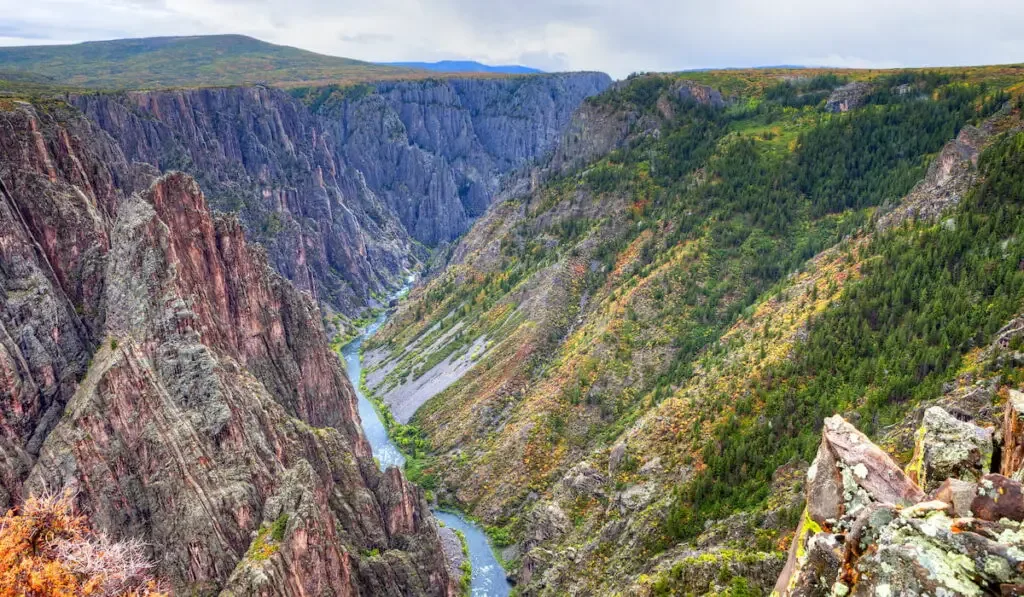
If you are about to compare the Grand Canyon with the Black Canyon of the Gunnison, stop right there because this park sits in its own class. Canyoneers or avid explorers will face totally different challenges and adventures when they embark on a journey into the deepest region of this national park.
From canyon exploring to high water kayaking on Gunnison River, Black Canyon of the Gunnison National park is a place for thrill-seekers of all types. Aside from extreme activities, there are a few trails with completely stunning views like the North Vista, Chams View, S.O.B. Draw, and Oak Flat Loop.
Located in western Colorado, this park was established on October 21, 1999.
- Best time to visit: From April to November when there is less snow.
- Admission fee: $10 per individual, $20 per vehicle, valid for 7 days.
- More information can be found on this website: https://www.nps.gov/blca/index.htm
24. Mesa Verde National Park
Mesa Verde National Park was established on June 29, 1906 and designated as a UNESCO World Heritage site in 1978. Located in Montezuma County, Colorado, this park is a vast historical land to almost 5,000 individual archaeological sites.
Some of the old structures that can be found on this land are alcove houses, cliff dwellings, hard sandstone ancient homes, and many more. There are also a few major sites that attract visitors every year like the Cliff Palace, Balcony House, Square Tower houses, Long House, Mug House, Spruce Tree House, and Oak Tree House.
- Best time to visit: From April to October when most services are available.
- Admission fee: Summertime: $15 per individual, $30 per vehicle, valid for 7 days. Wintertime: $10 per individual, $20 per vehicle, valid for 7 days.
- More information can be found on this website: https://www.nps.gov/meve/index.htm
25. Great Sand Dunes National Park

Located in south-central Colorado, this park contains the tallest sand dune in North America, the Star Dune that stands at 750 feet high. The Great Sand Dunes was established as a national park on September 24, 2004.
The dunes also contain deposits of magnetite that look like random dark patches from afar. Its ecosystem can be divided into four categories: the dune field, the sand sheet, the sabkha, and the mountain watershed.
Numerous activities can be done in this park including hiking, sandboarding, sand sledding, and a thrilling 4-wheel drive ride along the Medano Pass Primitive Road.
- Best time to visit: Spring and fall for cooler weather.
- Admission fee: $15 per individual, $25 per vehicle, valid for 7 days.
- More information can be found on this website: https://www.nps.gov/grsa/index.htm
Florida
26. Everglades National Park
Everglades National Park is the largest tropical park located in Florida and the third-largest national park in the United States. This park was established in 1934 before being redesignated for the last time in 1979.
Covering an area of 1,508, 976 acres, Everglades consists of tropical ecosystems, a network of wetlands, and the largest mangrove ecosystem in the Western Hemisphere. This land is also a habitat for a variety of plants and animals.
Some of the popular activities that can be done in Everglades are boat tours, trail-walking, and camping on designated camping sites.
- Best time to visit: Spring for kayaking or in the winter for cooler and dry weather.
- Admission fee: $15 per individual, $30 per vehicle, valid for 7 days.
- More information can be found on this website: https://www.nps.gov/ever/index.htm
27. Biscayne National Park

This national park is completely different than the other parks. It majorly sits underwater to protect the Biscayne Bay, diverse mangrove forests, and its offshore barrier reefs.
Established as a national park on June 28, 1980, Biscayne covers an area of 172,971 acres and is divided into four different ecosystems: shallow waters, coral limestone keys, offshore reefs, and mangrove swamps.
Some of the marine wildlife that inhabits this park are sea turtles, manatees, small fish, sawfish, and a small population of American crocodiles and alligators.
Although this park is entirely underwater, visitors are allowed to do some activities like snorkeling, scuba diving, kayaking, and windsurfing.
- Best time to visit: In the summer or fall for the best snorkeling experience.
- Admission fee: None
- More information can be found on this website: https://www.biscaynenationalparkinstitute.org/
28. Dry Tortugas National Park
Dry Tortugas National Park is one of the largest forts in the United States, Fort Jefferson, and seven dry Tortugas Islands off the coast of Key West, Florida.
Established as a national park on January 4, 1935, Dry Tortugas is rich with marine life and an underwater ecosystem that houses different marine animals and plants.
On the islands, over 200 species of birds like terns, pelicans, and boobies can be found as they migrate from other places when seasons change.
Some of the popular activities for visitors are snorkeling, scuba diving, boat tours, and bird watching.
- Best time to visit: In the spring or fall to watch birds’ migration.
- Admission fee: $15 per individual, valid for 7 days.
- More information can be found on this website: https://www.drytortugas.com/
Hawaii
29. Hawaii Volcanoes National Park
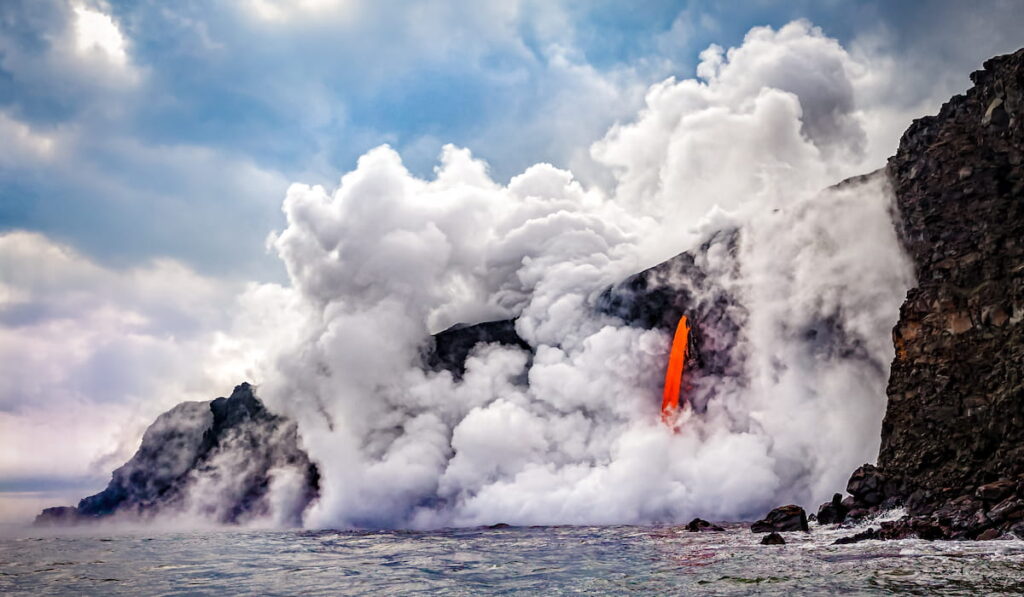
Located on the northern side of Hawaii Island, this park comprises of two of the largest and most active volcanoes in the United States; the Mauna Loa and the Kilauea. Hawaii Volcanoes National Park was established on August 1, 1916, and covers an area of 323,431 acres.
Aside from the active volcanoes, there are a few popular trails for visitors to explore including Pu’u Loa, Kilauea Iki, Thurston Lava Tube, and Crater Rim. Visitors can also learn about this park at the main visitor center located within the park entrance.
- Best time to visit: Spring or fall to avoid the rainy season.
- Admission fee: $12 per individual, $25 per vehicle, valid for 7 days.
- More information can be found on this website: https://www.nps.gov/havo/index.htm
30. Haleakala National Park
Dubbed as the ‘House of the Sun’ by the ancient people of Hawaii, Haleakala National Park is located on the Island of Maui and covers an area of 33,265 acres.
This land was established as a national park on July 1, 1961, before being designated as the International Biosphere Reserve in 1980.
Haleakala’s main attraction is its volcanic area, specifically the summit area named the Haleakala Crater. Visitors are allowed to take a tour around the dormant volcano and enjoy the magnificent view of Maui Island from atop. Other hotspots that can be found in this park are the Haleakala Observatory and the Kipahulu Forest Reserve.
- Best time to visit: In the spring or fall to avoid the wet and rainy seasons.
- Admission fee: $15 per individual, $30 per vehicle, valid for 7 days.
- More information can be found on this website: https://www.nps.gov/hale/index.htm
Kentucky
31. Mammoth Cave National Park

Mammoth Cave has the longest cave system in the world that stretches over 372.82 miles. Located in west-central Kentucky, this national park was established on July 1, 1941, and designated as a World Heritage Site on October 27, 1981. The underground passageways are full of limestone that enhances the amazing geological features inside this cave.
Other structures that would leave visitors in awe are cave bacon, hidden chambers, extensive tunnels, flowstone, and labyrinths of waterfalls. Cave exploration is allowed by certified tour guides to prevent visitors from getting lost inside the cave system.
- Best time to visit: The cave is open every day but fall is the best time for hiking activities.
- Admission fee: No entrance except for the cave tours.
- More information can be found on this website: https://www.nps.gov/maca/planyourvisit/basicinfo.htm
Indiana
32. Indiana Dunes National Park
Redesignated as a national park on February 15, 2019, this urban park offers some of the best views to watch the Chicago skyline from its beach on a clear sunny day. Indiana Dunes National Park is located in northwestern Indiana and covers a small area of 15,349 acres.
This park is well-known for its creeks and rivers such as Dunes Creek, Trail Creek, Salt Creek, and East Arm Little Calumet River. It is filled with families looking for a short escape from nearby cities during the summer.
- Best time to visit: In the summer for the best swimming experience.
- Admission fee: No entrance fee except $6 per vehicle to enter West Beach.
- More information can be found on this website: https://www.indianadunes.com/
Maine
33. Acadia National Park
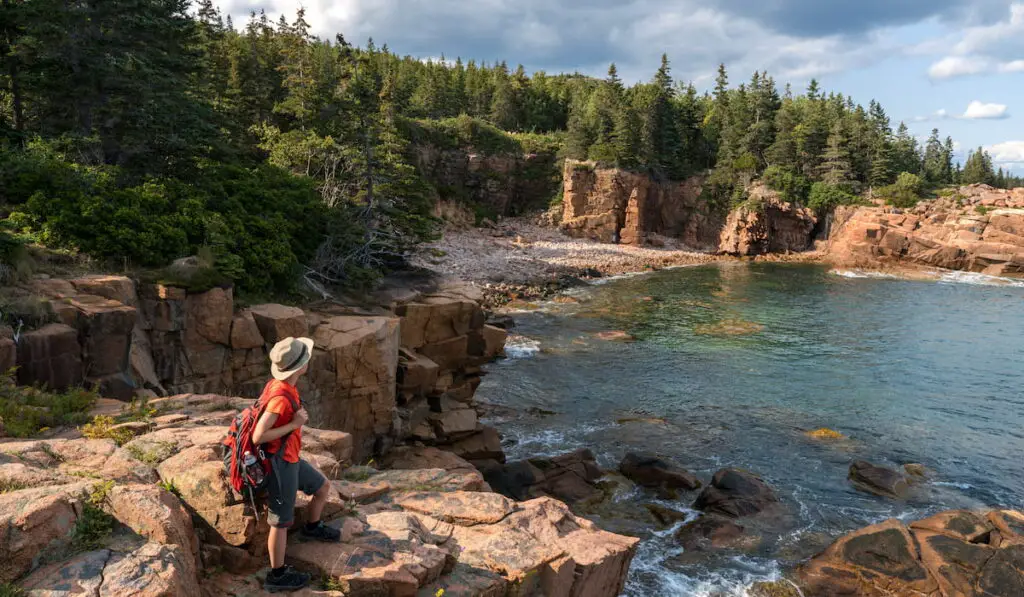
Acadia National Park is situated on a specific island found on the southern coast of Maine and southwest of Bar Harbor. This park was home to the Wabanaki Native Americans before being established on January 19, 1929.
Some of the beautiful landmarks that can be found in Acadia are Mount Desert Island, Mt. Penobscot, the Schoodic Peninsula, Cadillac Mountain, and the Isle au Haut districts.
Apart from kayaking and horseback riding, visitors are welcome to enjoy the panoramic view on many trails like the Jordan Pond, the Beehive Trails, and the Precipe Trails.
- Best time to visit: From September to October to watch beautiful leaves.
- Admission fee: $15 per individual, $30 per vehicle, valid for 7 days.
- More information can be found on this website: https://acadiamagic.com/
Michigan
34. Isle Royale National Park
Surrounded by more than 400 small islands, the Isle Royale National Park is located in the state of Michigan and covers an area of 571,790 acres. This park was established on April 3, 1980, and was declared the UNESCO International Biosphere Reserve in the same year.
This park offers many activities including hiking, scuba diving, backpacking, bird watching, as well as boat tours. The Isle Royale can only be reached by plane or boat, making it one of the least visited national parks in the United States.
- Best time to visit: When it’s open from April 15 to November 1, each year.
- Admission fee: $7 per individual, valid for a day.
- More information can be found on this website: https://www.nps.gov/isro/index.htm
Minnesota
35. Voyageurs National Park

The Voyageurs National Park covers an area of 218,000 acres in Northern Minnesota and sits on the border between the United States and Canada.
Established as a national park on April 8, 1975, Voyageurs predominantly consists of a diverse network of waterways with four big lakes: the Namakan, Rainy, Kabetogama, and Sand Point. Numerous activities can be done by visitors including fishing, camping, hiking, kayaking, canoeing, and motorboat tours.
- Best time to visit: In September to avoid mosquitoes, hot weather, and the crowd.
- Admission fee: No entrance fee except for the boat tours.
- More information can be found on this website: https://www.nps.gov/voya/index.htm
Missouri
36. Gateway Arch National Park
The Gateway Arch National Park consists of three major structures; the Gateway Arch, the Old Court House, and the Museum at the Gateway Arch. Located in St. Louis, Missouri, this modern-like national park was recently established on February 22, 2018.
Gateway Arch is not like other national parks. There are no scenic drives, hiking trails, or even mountains to climb. But this park is unique on its own where it has monumental buildings and two historical museums. One museum can be found in the Old Court House and the other in the Gateway Arch Complex.
- Best time to visit: Anytime, especially when the weather is good.
- Admission fee: $3 per individual for the entrance fee, $12 per individual for a tram ride to the top of the Arch.
- More information can be found on this website: https://www.gatewayarch.com/
Montana
37. Glacier National Park
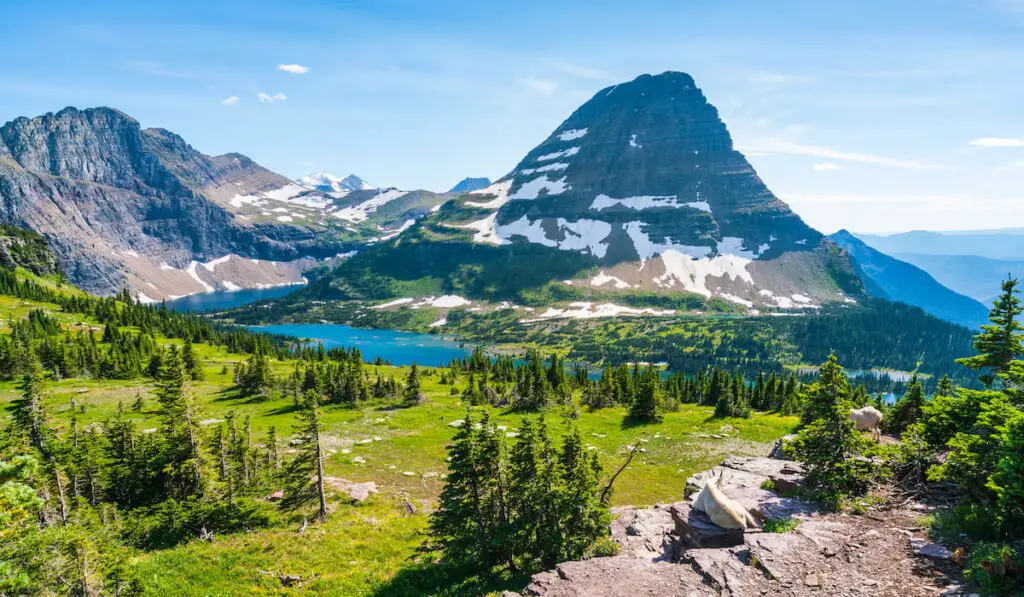
Located between the United States and Canada in northwestern Montana, this beautiful park covers an area of 1,013,322 acres with a largely preserved ecosystem known as the ‘Crown of the Continent Ecosystem’. This national park was established on May 11, 1902, and was renowned as World Heritage Site in 1995.
Glacier National Park is a perfect getaway place for people who love open forests with towering mountain ranges that sit around this land. Numerous activities are permitted in this park including hiking, climbing, and even fly fishing.
- Best time to visit: In the spring or fall when fewer people are visiting.
- Admission fee: $20 per individual, $35 per vehicle, valid for 7 days.
- More information can be found on this website: https://glacier.org/
Nevada
38. Great Basin National Park

The Great Basin National Park is located in White Pine County in east-central Nevada. Established as a national park on October 27, 1986, the Great Basin is home to over 800 species of plants and 300 species of animals. Some of the bristlecone pine trees found in this park are also the longest-living trees in the world, surviving for more than 5,000 years.
Aside from its natural attractions, there are several hot spots for visitors to enjoy the landscapes including the Wheeler Peak Glacier, the Stella Lake, the Aqueduct, and the Lehman Orchard.
- Best time to visit: In the summer for the best hiking experience and winter for cross-country skiing.
- Admission fee: None
- More information can be found on this website: https://www.greatbasinpark.com/
39. Death Valley National Park
Although the temperature in this park can reach up to 134 F during the hot season, that does not stop visitors from coming to the Death Valley National Park. Located on the California-Nevada border, this hottest and driest park in the United States was established as a national park on October 31, 1994.
Some of the landmarks that attract the most visitors are the Badlands, Bad Water Basin, Mojave Desert, Mosaic Canyon, Telescope Peak, and Mesquite Salt Flat Sand Dunes.
Visitors are allowed to do many activities like hiking, mountain biking, motorbiking, and even camping.
- Best time to visit: In the spring for blooming wildflowers and winter for a cooler temperature.
- Admission fee: $15 per individual, $30 per vehicle, valid for 7 days.
- More information can be found on this website: https://www.nps.gov/deva/index.htm
New Mexico
40. White Sands National Park
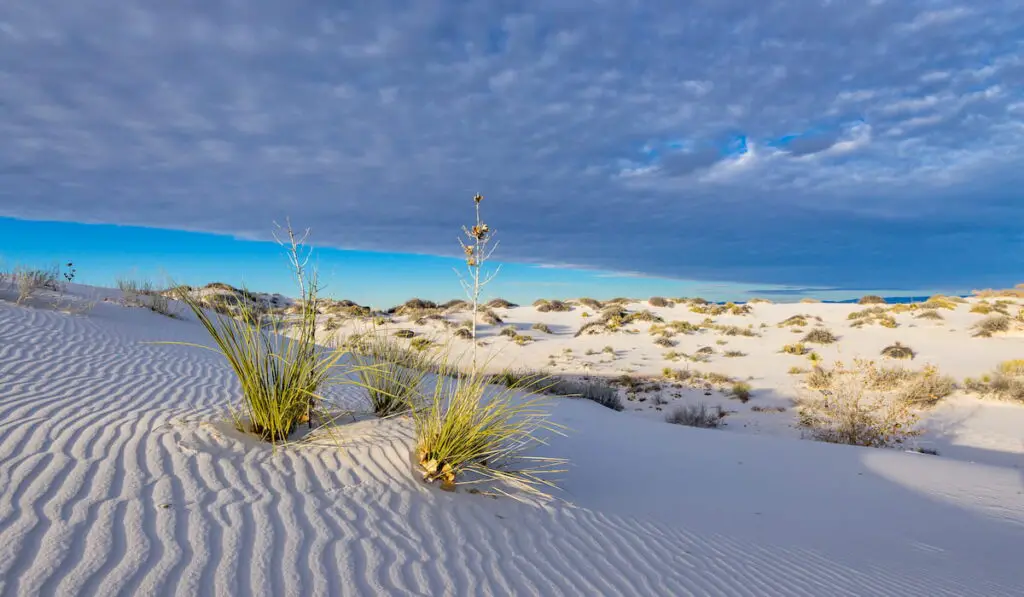
White Sands is the most recent land that was established as a national park on December 20, 2019. Located in the state of New Mexico, this park covers an area of 145,762 acres surrounded by the White Sands Missile Range.
One of the main attractions of this land is the gypsum dune field, which is the largest dune field in the world.
Due to the mostly-white ecosystem, some species of animals found in this place are also white because they mimic the color of their environment for survival purposes.
Visitors can take a walk on a few popular trails like the Dune Life Nature Trail, the Interdune Boardwalk, and the Backcountry Camping Trail.
- Best time to visit: Any day except early July to mid-October to avoid the monsoon season.
- Admission fee: $10 per individual, $20 per vehicle, valid for 7 days.
- More information can be found on this website: https://www.nationalparks.org/explore-parks/white-sands-national-monument
41. Carlsbad Caverns National Park
Located in the Guadalupe Mountains of southeastern New Mexico, this park consists of 119 smaller caves or rooms with two main entrances: the Caverns Historic District and the Rattlesnake Springs Historic District. Carlsbad Caverns was established as a national park on May 14, 1930.
Unique mineral formations, numerous chambers, and channels are some of the features that make the cave systems on this park better than others. On the upper side, protected areas are regularly being monitored to maintain a healthy environment for many wildlife and plants.
- Best time to visit: In the summer to witness the nightly bat visits.
- Admission fee: $15 per individual, valid for 3 days.
- More information can be found on this website: https://www.nps.gov/cave/index.htm
North Dakota
42. Theodore Roosevelt National Park
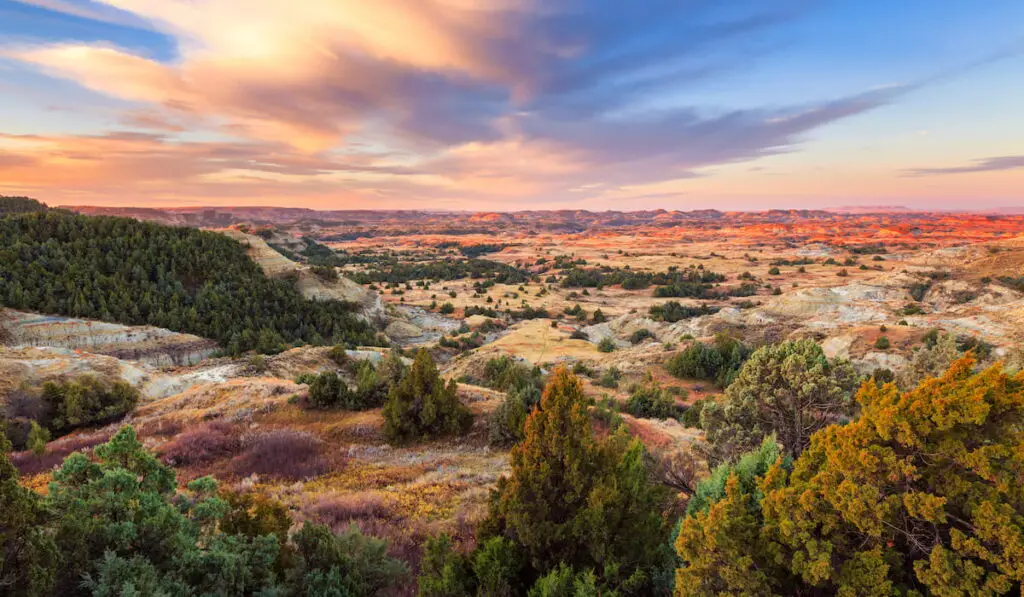
Named after the 6th President of the United States, this beautiful park is located in North Dakota and covers an area of 70,446 acres.
This park was established as a national park on November 10, 1978 and offers numerous activities to visitors ranging from 100 miles of horse trails, scenic drives, hiking, camping, to wildlife watching. This park is divided into three regions; North, South, and Elkhorn.
Also, horseback riding and back-country hiking have become some of the most popular activities that attract more visitors to this place year after year.
- Best time to visit: In spring to watch beautiful wildflowers or in summer for recreational activities.
- Admission fee: $15 per individual, $30 per vehicle, valid for 7 days.
- More information can be found on this website: https://www.nps.gov/thro/index.htm
Ohio
43. Cuyahoga Valley National Park
Cuyahoga Valley National Park protects the rural region along Cuyahoga River between Akron and Cleveland in northeast Ohio. Established as a national park on October 11. 2000, this land is more urbanized compared to some of the other national parks in the United States.
Its landscapes encompass a few small towns, roads, 15 smaller parks that attracts many visitors to this place.
Although their ecosystem is not as dense as other preserved forests, this park houses many kinds of wildlife like coyotes, red foxes, muskrats, great blue herons, beavers, white-tailed deers, and many more.
Visitors can enjoy an amazing view in the autumn and spring when they take a walk on many trails found in this park.
- Best time to visit: In autumn to watch changing leaves and spring for blooming wildflowers.
- Admission fee: None
- More information can be found on this website: https://www.nps.gov/cuva/index.htm
Oregon
44. Crater Lake National Park
Crater Lake is the deepest lake in the United States with a depth of 1,934 feet. Located in southern Oregon, this land was established as a national park on May 22, 1902. Crater Lake National Park features different natural attractions like beautiful ecosystems, scenic landscapes, cultural spots, and volcanic features.
The dark brown or dark grayish soil on this land is derived from all volcanic activities of Mount Mazama situated nearby.
Numerous activities are available for visitors like hiking, camping, and scenic drives.
- Best time to visit: In the summer for easy access.
- Admission fee: $12 per individual, $25 per vehicle, valid for 7 days. The fee is only charged in the summer.
- More information can be found on this website: https://www.nps.gov/crla/index.htm
South Carolina
45. Congaree National Park, South Carolina

Congaree National Park preserves the largest intact expanse of old-growth bottomland hardwood forest. Simultaneously, this forest forms one of the highest temperate deciduous forest canopies in the world.
Established as a national park on November 10, 2003, this park is located in central South Carolina and covers an area of 26,276 acres. It is also designated as a UNESCO biosphere reserve.
Congaree offers many interesting activities to visitors that love to experience the green ecosystem in its wilderness. This includes hiking, camping, canoeing, kayaking, and bird watching.
- Best time to visit: Anytime in the year except for weekends when the park is crowded.
- Admission fee: None
- More information can be found on this website: https://www.nationalparks.org/connect/explore-parks/congaree-national-park
South Dakota
46. Wind Cave National Park
Wind Cave National Park is the first cave that was established as a national park by President Theodore Roosevelt on January 3rd, 1903. Located near the Hot Springs in western South Dakota, this park is the seventh longest cave in the world with passageways that measure up to 149.01 miles in length.
Aside from cave exploration, visitors can also enjoy a hike along many beautiful trails like the Lookout Point, Boland Ridge, Highland Creek, Rankin Ridge, and Wind Cave Canyon.
- Best time to visit: In the summer and fall for the best hiking experience, or in the spring when wildflowers are blooming.
- Admission fee: No entrance fee except for cave tours.
- More information can be found on this website: https://www.nps.gov/wica/index.htm
47. Badlands National Park
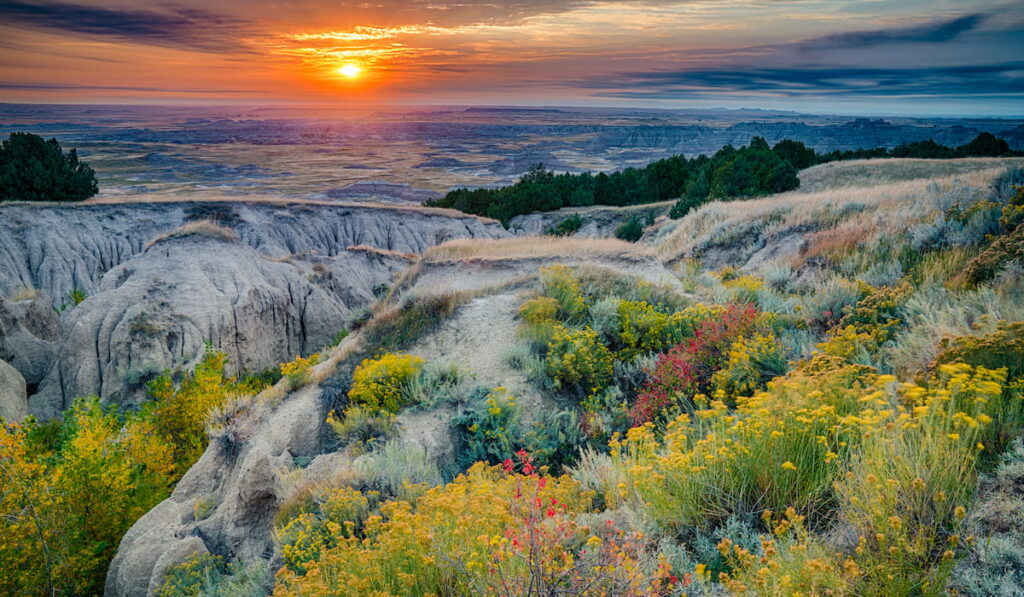
At first glance, Badlands National Park might look like a deserted place, but there is more to this land than meets the eye. Located in southwestern South Dakota, this 242,766 acres park was established as a national park on November 10, 1978.
Badlands majorly consists of eroded pinnacles and buttes with wild mixed-grass prairie covering the undisturbed land.
Many kinds of wildlife inhabit this park including bobcat, coyote, bighorn sheep, black-billed magpie, bison, badger, and many more.
Visitors can go on a scenic drive along these two most favorite trails; the Sage Creek road and the Badlands Loop Road.
- Best time to visit: In the spring or fall for clearer weather.
- Admission fee: $15 per individual, $30 per vehicle, valid for 7 days.
- More information can be found on this website: https://www.nps.gov/badl/index.htm
Tennessee
48. Great Smoky Mountains National Park
Located in the southeastern United States, this national park is the most popular park known for its mesmerizing landscapes and beautiful trails that attract many hikers from all over the country.
Established as a national park in 1940 before being designated as a UNESCO World Heritage site in 1983, Great Smoky Mountains is also home to an abundance of plants and wildlife.
A few historical sites like the Cade Coves and Cataloochee Valley are some of the many reasons why people would frequently visit this park.
- Best time to visit: In the fall for autumn leaves and less crowd.
- Admission fee: None
- More information can be found on this website: https://smokymountains.com/park/
Texas
49. Guadalupe Mountains National Park

This gigantic mountain range was established as a national park on September 30, 1972. Located in the east of El Paso, Texas, this national park consists of Guadalupe Peak that stands at 8,751 feet, and El Capitan that was once used as a landmark by travelers.
Aside from the mountainous landscape, there are other beautiful landscapes such as the McKittrick Canyon and the Manzanita spring.
Hiking, horse riding, and ranching are some of the interesting activities that can be done at this park.
- Best time to visit: In the spring for a better hiking experience or from October to November to watch beautiful plants and leaves.
- Admission fee: $7 per individual, valid for 7 days.
- More information can be found on this website: https://www.nps.gov/gumo/index.htm
50. Big Bend National Park, Texas
The Big Bend National Park is located in West Texas near the border of Mexico. This park was established as a national park on June 12, 1944, and the largest home to many registered species of birds in North America.
The Big Bend has a hot semi-arid climate with the Chihuahuan desert that sustains many wildlife and plants.
Some of the popular trails for avid hikers and backpackers are the Chimneys Trail, the Marufo Vega Trail, the Boot Canyon, the Lost Mine, and the Emory Peak.
- Best time to visit: In the spring to watch bird migration or from October to April for cooler temperatures.
- Admission fee: $15 per individual, $30 per vehicle, valid for 7 days.
- More information can be found on this website: https://visitbigbend.com/
Utah
51. Capitol Reef National Park
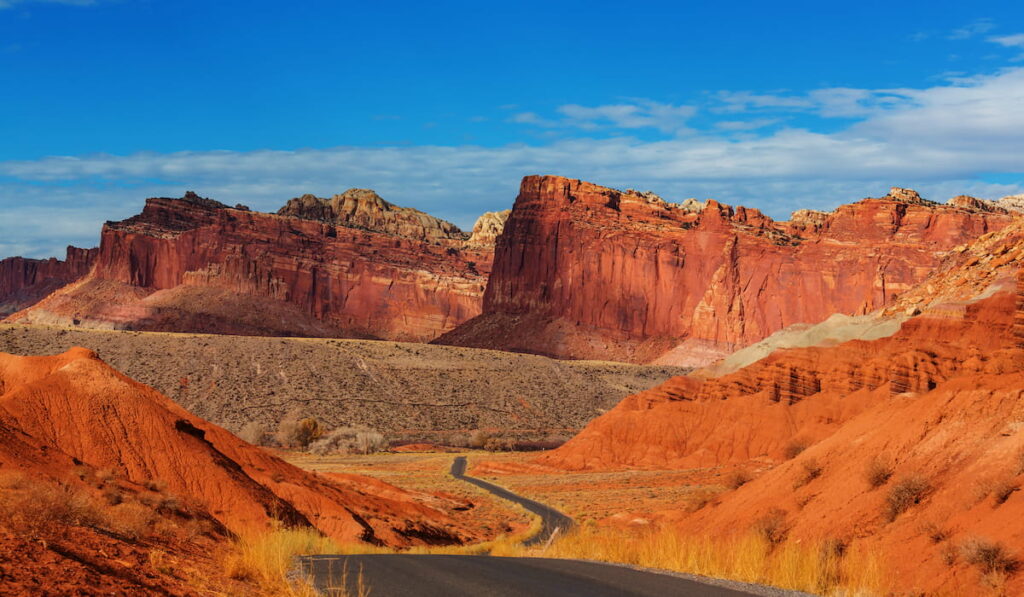
Capitol Reef National Park was established as a national park on December 18, 1971. This place is located in south-central Utah and covers an area of 241,904 acres. Capitol Reef is part of the Waterpocket Fold, which is the largest exposed monocline in North America.
This park is also the only national park when visitors are free to pick apples and fruits from the orchards. Other attractive landmarks that can be found are the Hickman Bridge, Capitol Gorge, Golden Throne Mountain, Cassidy Arch, and Sunset Point.
- Best time to visit: From June to October when the orchards are blooming.
- Admission fee: $10 per individual, $20 per vehicle, valid for 7 days.
- More information can be found on this website: https://capitolreef.org/
52. Arches National Park
With over 2000 natural sandstone arches, this national park has been the ‘red-rock wonderland’. Established as a national park on April 12, 1929, the Arches is based in the eastern part of Utah and to the north of the town of Moab.
One of the main attractions of this place is the Arches Scenic Drive that will take visitors out on a journey along beautiful trails surrounded by giant red rocks. Other activities that are allowed in this park are hiking, bicycling, rock climbing, camping, and canyoneering.
- Best time to visit: In the spring and fall for milder temperatures.
- Admission fee: $15 per individual, $30 per vehicle, valid for 7 days.
- More information can be found on this website: https://www.nps.gov/arch/index.htm
53. Zion National Park
Although this park is relatively small compared to other famous parks, there is more to this place than just canyons and towering summits. Located near the town of Springdale in southwestern Utah, Zion National Park is split into four different life zones; desert, woodland, coniferous forest, and riparian.
Established as a national park on November 19, 1919, this land is home to different varieties of flora and wildlife. Visitors frequently visit this place due to its beautiful landscapes that include mesas, mountains, slot canyons, natural arches, as well as rivers. Plus, the Colorado and Green Rivers are best for kayaking and canoeing.
- Best time to visit: From April to November when the place isn’t covered with snow.
- Admission fee: $10 per individual, $20 per vehicle, valid for 7 days.
- More information can be found on this website: https://zionnationalpark.com/
54. Canyonlands National Park
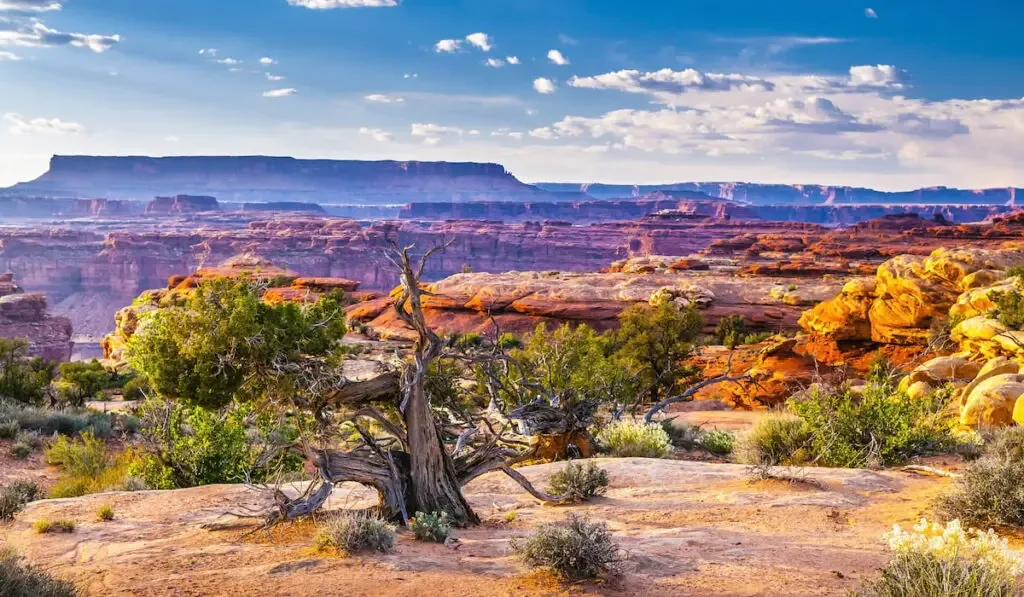
This national park is located in the southeastern region of Utah near the town of Moab. Established as a national park on September 12, 1964, this park consists of three different regions; Islands In The Sky, Needles, and The Maze.
Different regions offer different activities like magnificent canyon drive, rock spires-viewing, and trail-walking into the wilderness.
The abundance of flora and fauna on this park is one of the reasons why this park is still famous up to these days. These include cactuses, wildflowers, black bears, skunks, coyotes, and many more.
- Best time to visit: In the spring and fall for better weather.
- Admission fee: $15 per individual, $30 per vehicle, valid for 7 days.
- More information can be found on this website: https://www.nps.gov/cany/index.htm
55. Bryce Canyon National Park
Bryce Canyon National Park is located in southwestern Utah near Zion National Park. Unlike the Grand Canyon, this land is not entirely a canyon but a cluster of gigantic natural amphitheaters along the eastern side of the Paunsaugunt Plateau.
Established as a national park on February 2, 1928, this park offers different activities for visitors to enjoy like the scenic drive, camping, horse riding, and hiking along the Rim Trail and the Riggs Spring Loop Trail.
- Best time to visit: In the winter when fewer people are visiting. But be prepared for snow or closed roads.
- Admission fee: $20 per individual, $35 per vehicle, valid for 7 days.
- More information can be found on this website: https://www.brycecanyoncountry.com/
Virgin Islands
56. Virgin Islands National Park
This beautiful and well-preserved park is located on the Island of St. John which covers an area of 14,737 acres. This small chain of islands based in the Caribbean was established as a national park on August 2, 1956.
The Virgin Islands National Park is well-known for its scuba diving that allows visitors to explore the beauty of marine animals like sea turtles and pearly-eyed thrashers.
Apart from its white sandy beaches, people can also explore the tropical rainforests, coastal areas, and beautiful bays in this park such as Caneel Bay and Trunk Bay.
- Best time to visit: Any month except December to April to avoid hurricane season.
- Admission fee: None
- More information can be found on this website: https://www.nps.gov/viis/index.htm
Virginia
57. Shenandoah National Park
Shenandoah National Park covers an area of almost 200,000 acres that are considered a part of the Blue Ridge Mountains in the state of Virginia. Established as a national park on December 26, 1935, Shenandoah is perfect to find solitude and peace of mind, away from the bustling cities.
Apart from hiking trails, visitors can also enjoy the amazing views of the mountains and cascading waterfalls by riding Skyline Drive. Also, different varieties of beautiful plants and wildlife can be found including wildflowers, black bears, deer, and many more.
- Best time to visit: Autumn to watch beautiful foliage and leaves.
- Admission fee: $15 per individual, $30 per vehicle, valid for 7 days.
- More information can be found on this website: https://visitshenandoah.org/poi/shenandoah-national-park/
Washington
58. Olympic National Park
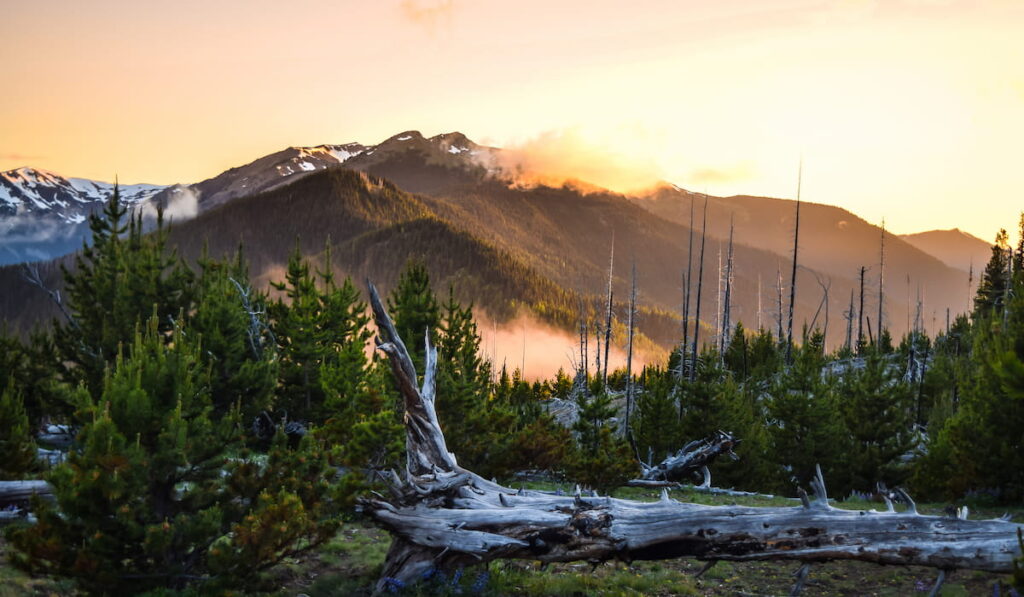
Located in the far west of Washington just below Vancouver Island, Olympic National Park can be divided into four regions; the Pacific coastline, the west-side temperate rainforest, alpine regions, and dry forests on the east side.
This land was established as a national park on June 29, 1968, right after it was re-designated by Congress and President Franklin Roosevelt.
The coastal region of the park is sandy and the central region consists of a series of glaciated mountains like Mount Olympus and Mount Deception.
Aside from the natural attractions, camping and hiking have become some of the most popular activities in this park.
- Best time to visit: In the summer when the weather is clear and the roads are open.
- Admission fee: $15 per individual, $30 per vehicle, valid for 7 days.
- More information can be found on this website: https://www.olympicnationalparks.com/
59. North Cascades National Park
The North Cascades was established as a national park on October 2, 1968. It covers an area of 500,000 acres in the northern region of the state of Washington near the Canadian border.
Numerous activities are available in this park including mountaineering, climbing, hiking, and bicycling.
Apart from its beautiful mountainous landscapes and an abundance of wildlife, there are about 1600 species of plants that can be found on this land.
- Best time to visit: From May to October, to avoid winter storms.
- Admission fee: None
- More information can be found on this website: https://www.nps.gov/noca/index.htm
60. Mount Rainier National Park
This national park is located in southeast Pierce County and northeast Lewis County in Washington state. Established as a national park on March 2, 1899, by President William McKinley, Mount Rainier is one of the best places for mountaineers and hikers to challenge themselves on a 93-mile long hiking trail.
This land that covers an area of 236,000 acres filled with a variety of natural attractions like beautiful wildflowers, shimmering glaciers, and mesmerizing waterfalls.
- Best time to visit: In the summer for blooming wildflowers.
- Admission fee: $15 per individual, $30 per vehicle, valid for 7 days.
- More information can be found on this website: https://mt-rainier.com/
West Virginia
61. New River Gorge National Park
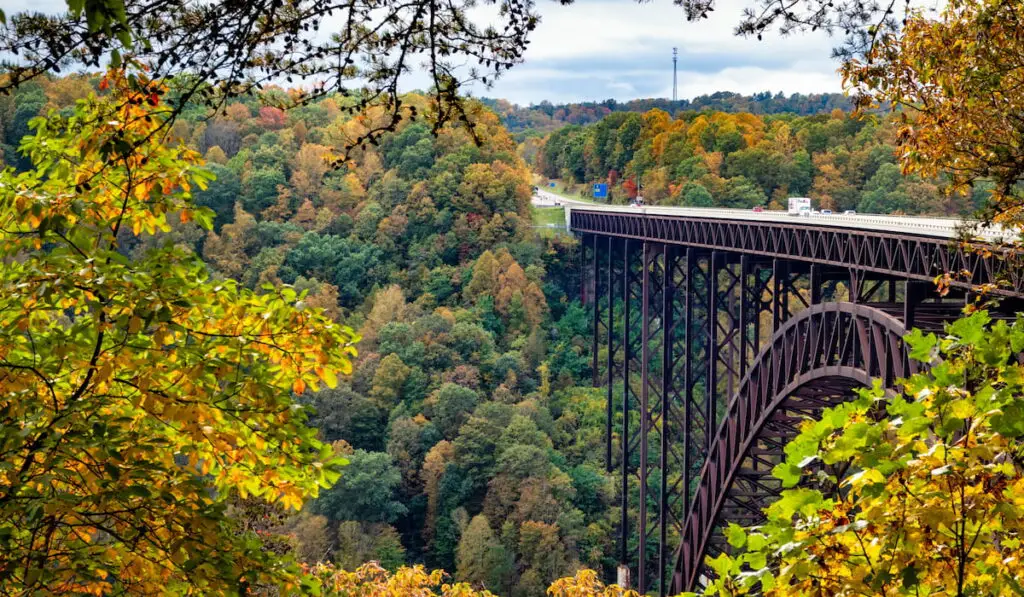
This 70,000 acres of land along the New River is located in southern West Virginia in the Appalachian mountains. Established as a national park on November 10, 1978, by President Jimmy Carter, New River is one of the oldest rivers in North America and popular for its whitewater rafting activity.
The beautiful landscapes of this park also offer numerous on-land activities like hiking, biking, rock climbing, camping, fishing, canoeing, bird-watching, hunting, and more.
- Best time to visit: In the fall for the best nature experience, from April to October for whitewater rafting.
- Admission fee: None
- More information can be found on this website: https://www.nps.gov/neri/index.htm
Wyoming
62. Grand Teton National Park
Grand Teton was established as a national park on February 26, 1929, by President Calvin Coolidge. This 310,000 acres of land is located south of Yellowstone National Park.
Grand Teton is famous for its mountainous landscapes and is made for avid hikers. Some of the natural attractions are Jackson Lake, Snake River, and the National Elk Refuge which are all a part of the valley found in this place.
There are also many different plants and wildlife that inhabit the forests and plains to mesmerize the hearts and minds of every visitor that come to this place.
- Best time to visit: During autumn, from September to October.
- Admission fee: $20 per individual, $35 per vehicle, valid for 7 days.
- More information can be found on this website: https://www.gtnpf.org/
63. Yellowstone National Park
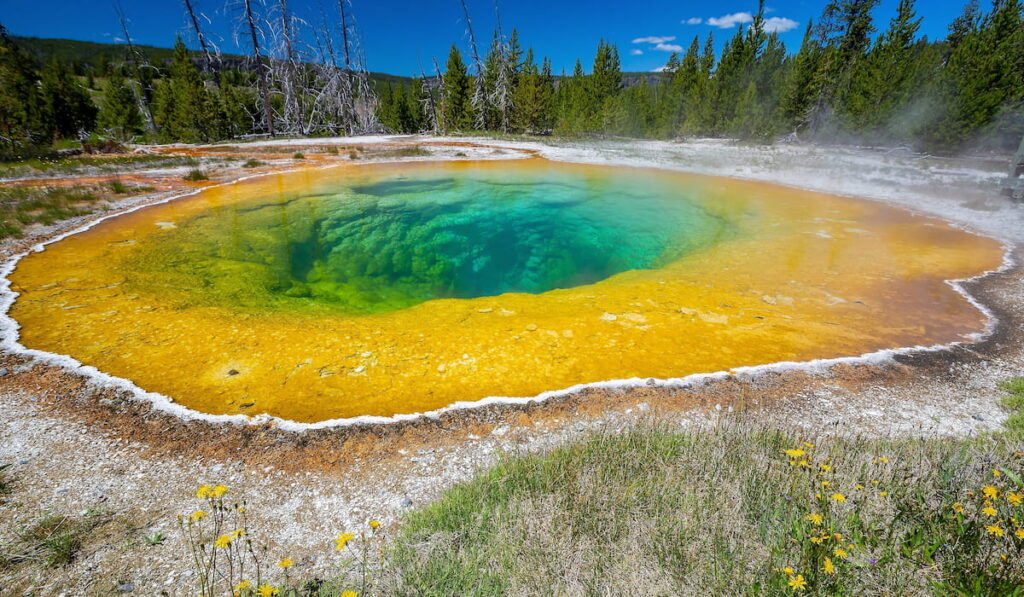
This amazing 2.2 million acres national park is the flagship for all the 63 parks found in the United States.
Established as a national park on March 1, 1872, this preserved land is filled with varieties of megafauna, wolves, grizzly bears, free-roaming bison and elk, and beautiful landscapes like erupting geysers and hot springs.
Numerous activities are available for visitors so they can get the most out of being in this place. Apart from normal activities like climbing, hiking, and fishing, you can also enjoy snowmobiles and snow coaches in the winter.
- Best time to visit: In the winter when fewer people are visiting.
- Admission fee: $20 per individual, $35 per vehicle, valid for 7 days.
- More information can be found on this website: https://www.yellowstonenationalpark.com/
Final Thoughts
All of these 63 national parks possess their own unique features in terms of geology, ecosystem, and natural attractions.
Although there are roughly 420 national park sites throughout the United States, only 63 parks were approved by Congress.

